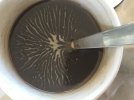Ina
The Living Force
This morning, I made myself a cup of cold instant coffee with bottled water. Took it on a table outside, stirred the sugar, noticed some small cirrus like micro foam forming, had a sip and left it for about an hour as I needed to check on my work and start running a processing job. When I came back to finish the coffee, I found a tree like pattern on the coffee surface stemming from the teaspoon left in the cup. I am thinking that my coffee today was slightly conductive and reacted with the teaspoon in the presence of EM fields. what do you think?

